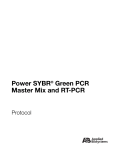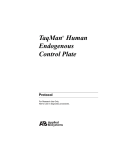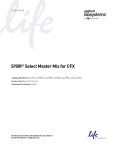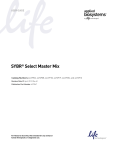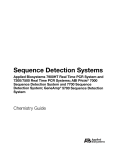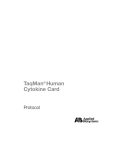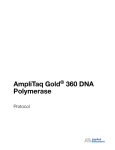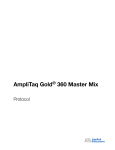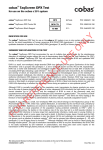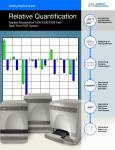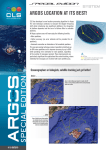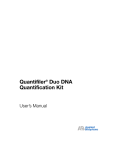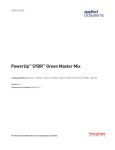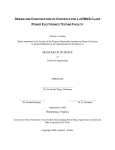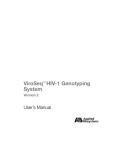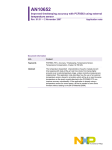Download Power SYBR® Green PCR Master Mix and Power SYBR® Green RT
Transcript
USER GUIDE Power SYBR® Green PCR Master Mix and Power SYBR® Green RT-PCR Reagents Kit Catalog Number 4368577, 4367659, 4367660, 4368706, 4368702, 4368708 (Master Mix) and 4368711 (RT-PCR Reagents Kit) Publication Part Number 4367218 Rev. E Revision Date September 2011 For Research Use Only. Not intended for any animal or human therapeutic or diagnostic use. Information in this document is subject to change without notice. LIFE TECHNOLOGIES AND/OR ITS AFFILIATE(S) DISCLAIM ALL WARRANTIES WITH RESPECT TO THIS DOCUMENT, EXPRESSED OR IMPLIED, INCLUDING BUT NOT LIMITED TO THOSE OF MERCHANTABILITY OR FITNESS FOR A PARTICULAR PURPOSE. IN NO EVENT SHALL LIFE TECHNOLOGIES AND/OR ITS AFFILIATE(S) BE LIABLE, WHETHER IN CONTRACT, TORT, WARRANTY, OR UNDER ANY STATUTE OR ON ANY OTHER BASIS FOR SPECIAL, INCIDENTAL, INDIRECT, PUNITIVE, MULTIPLE OR CONSEQUENTIAL DAMAGES IN CONNECTION WITH OR ARISING FROM THIS DOCUMENT, INCLUDING BUT NOT LIMITED TO THE USE THEREOF. LIMITED USE LABEL LICENSE: Research Use Only The purchase of this product conveys to the purchaser the limited, non-transferable right to use this product only to perform internal research for the sole benefit of the purchaser. No right to resell this product or any of its components is conveyed expressly, by implication, or by estoppel. This product is for internal research purposes only and is not for use in commercial applications of any kind, including, without limitation, quality control and commercial services such as reporting the results of purchaser’s activities for a fee or other form of consideration. For information on obtaining additional rights, please contact [email protected] or Out Licensing, Life Technologies, 5791 Van Allen Way, Carlsbad, California 92008. The purchase of this product includes a limited, non-transferable license under U.S. Patents and corresponding claims in patents and patent applications outside the United States, owned by the University of Utah Research Foundation and licensed to Idaho Technology. Inc., to use only this amount of product for dsDNA-Binding Dye assays solely for the purchaser's own internal research and development activities. No right is conveyed, expressly, by implication or estoppel, under any other patent or patent claims, such as FRET patent claims of Idaho Technology, Inc., under any patent owned by Roche or AB. under any patent claim for an apparatus or system, or to use this product for any other purpose or commercial services of any kind. TRADEMARKS The trademarks mentioned herein are the property of Life Technologies Corporation or their respective owners. TaqMan, AmpliTaq Gold, and AmpErase are registered trademarks of Roche Molecular Systems, Inc. TaqMan is used under permission and license. © 2011 Life Technologies Corporation. All rights reserved. Contents About This Guide . . . . . . . . . . . . . . . . . . . . . . . . . . . . . . . . . . . . . . . . . . . . . . . . . 7 Purpose of the guide . . . . . . . . . . . . . . . . . . . . . . . . . . . . . . . . . . . . . . . . . . . . . . . . . . . . . . . . . . . . . . . . . . 7 User attention words . . . . . . . . . . . . . . . . . . . . . . . . . . . . . . . . . . . . . . . . . . . . . . . . . . . . . . . . . . . . . . . . . . 7 ■ CHAPTER 1 Product Information . . . . . . . . . . . . . . . . . . . . . . . . . . . . . . . . 9 Purpose of the Kit . . . . . . . . . . . . . . . . . . . . . . . . . . . . . . . . . . . . . . . . . . . . . . . . . . . . . . . . . . . . . . . . . . . . . 9 Advantages of the Kit . . . . . . . . . . . . . . . . . . . . . . . . . . . . . . . . . . . . . . . . . . . . . . . . . . . . . . . . . . . . . 9 Materials and Equipment . . . . . . . . . . . . . . . . . . . . . . . . . . . . . . . . . . . . . . . . . . . . . . . . . . . . . . . . . . . . . Description of Master Mix . . . . . . . . . . . . . . . . . . . . . . . . . . . . . . . . . . . . . . . . . . . . . . . . . . . . . . . . Performance Characteristics of the Kit . . . . . . . . . . . . . . . . . . . . . . . . . . . . . . . . . . . . . . . . . . . . . Storage and Stability . . . . . . . . . . . . . . . . . . . . . . . . . . . . . . . . . . . . . . . . . . . . . . . . . . . . . . . . . . . . . Materials Required but Not Supplied . . . . . . . . . . . . . . . . . . . . . . . . . . . . . . . . . . . . . . . . . . . . . . . ■ CHAPTER 2 10 10 10 11 11 PCR . . . . . . . . . . . . . . . . . . . . . . . . . . . . . . . . . . . . . . . . . . . . . . 13 Designing Custom Target Sequences for Quantitation . . . . . . . . . . . . . . . . . . . . . . . . . . . . . . . . . . . . . Overview . . . . . . . . . . . . . . . . . . . . . . . . . . . . . . . . . . . . . . . . . . . . . . . . . . . . . . . . . . . . . . . . . . . . . . . Identifying Target Sequence and Amplicon Size . . . . . . . . . . . . . . . . . . . . . . . . . . . . . . . . . . . . . . Designing Primers . . . . . . . . . . . . . . . . . . . . . . . . . . . . . . . . . . . . . . . . . . . . . . . . . . . . . . . . . . . . . . Selecting an Amplicon Site for cDNA . . . . . . . . . . . . . . . . . . . . . . . . . . . . . . . . . . . . . . . . . . . . . . . 13 13 13 13 14 Amplifying Custom Target Sequences for Quantitation . . . . . . . . . . . . . . . . . . . . . . . . . . . . . . . . . . . . 14 Ordering Reagents . . . . . . . . . . . . . . . . . . . . . . . . . . . . . . . . . . . . . . . . . . . . . . . . . . . . . . . . . . . . . . 14 Quantitating Primers . . . . . . . . . . . . . . . . . . . . . . . . . . . . . . . . . . . . . . . . . . . . . . . . . . . . . . . . . . . . 15 ■ CHAPTER 3 Reverse Transcription . . . . . . . . . . . . . . . . . . . . . . . . . . . . . . 17 Reverse Transcription for All Amplicons Except 18S . . . . . . . . . . . . . . . . . . . . . . . . . . . . . . . . . . . . . . Overview . . . . . . . . . . . . . . . . . . . . . . . . . . . . . . . . . . . . . . . . . . . . . . . . . . . . . . . . . . . . . . . . . . . . . . . Guidelines . . . . . . . . . . . . . . . . . . . . . . . . . . . . . . . . . . . . . . . . . . . . . . . . . . . . . . . . . . . . . . . . . . . . . . Two-Step RT-PCR RT Reaction Mix . . . . . . . . . . . . . . . . . . . . . . . . . . . . . . . . . . . . . . . . . . . . . . . . Thermal Cycling Parameters for RT Reactions . . . . . . . . . . . . . . . . . . . . . . . . . . . . . . . . . . . . . . Performing RT Reactions . . . . . . . . . . . . . . . . . . . . . . . . . . . . . . . . . . . . . . . . . . . . . . . . . . . . . . . . . 17 17 17 18 18 18 Reverse Transcription for the 18S Amplicon . . . . . . . . . . . . . . . . . . . . . . . . . . . . . . . . . . . . . . . . . . . . . Overview . . . . . . . . . . . . . . . . . . . . . . . . . . . . . . . . . . . . . . . . . . . . . . . . . . . . . . . . . . . . . . . . . . . . . . . Recommended Template . . . . . . . . . . . . . . . . . . . . . . . . . . . . . . . . . . . . . . . . . . . . . . . . . . . . . . . . . Template Quality . . . . . . . . . . . . . . . . . . . . . . . . . . . . . . . . . . . . . . . . . . . . . . . . . . . . . . . . . . . . . . . . Template Quantity . . . . . . . . . . . . . . . . . . . . . . . . . . . . . . . . . . . . . . . . . . . . . . . . . . . . . . . . . . . . . . . Guidelines . . . . . . . . . . . . . . . . . . . . . . . . . . . . . . . . . . . . . . . . . . . . . . . . . . . . . . . . . . . . . . . . . . . . . . Preparing the Reactions . . . . . . . . . . . . . . . . . . . . . . . . . . . . . . . . . . . . . . . . . . . . . . . . . . . . . . . . . Thermal Cycling . . . . . . . . . . . . . . . . . . . . . . . . . . . . . . . . . . . . . . . . . . . . . . . . . . . . . . . . . . . . . . . . 19 19 19 19 19 19 20 22 Power SYBR® Green PCR Master Mix and Power SYBR® Green RT-PCR Reagents Kit User Guide 3 Contents ■ CHAPTER 4 Optimizing Primer Concentrations . . . . . . . . . . . . . . . . . . 23 Optimizing Primer Concentrations for PCR . . . . . . . . . . . . . . . . . . . . . . . . . . . . . . . . . . . . . . . . . . . . . . Overview . . . . . . . . . . . . . . . . . . . . . . . . . . . . . . . . . . . . . . . . . . . . . . . . . . . . . . . . . . . . . . . . . . . . . . . . Optimizing Primer Concentrations for PCR . . . . . . . . . . . . . . . . . . . . . . . . . . . . . . . . . . . . . . . . . . PCR Master Mix for Primer Optimization . . . . . . . . . . . . . . . . . . . . . . . . . . . . . . . . . . . . . . . . . . . . Plate Configuration for Primer Optimization . . . . . . . . . . . . . . . . . . . . . . . . . . . . . . . . . . . . . . . . . Thermal Cycling Parameters for Primer Optimization . . . . . . . . . . . . . . . . . . . . . . . . . . . . . . . . Confirm the Absence of Nonspecific Amplification . . . . . . . . . . . . . . . . . . . . . . . . . . . . . . . . . . . . 23 23 23 24 24 25 25 Optimizing Primer Concentrations for One-Step RT-PCR . . . . . . . . . . . . . . . . . . . . . . . . . . . . . . . . . . Overview . . . . . . . . . . . . . . . . . . . . . . . . . . . . . . . . . . . . . . . . . . . . . . . . . . . . . . . . . . . . . . . . . . . . . . . . Reducing Nonspecific Amplification . . . . . . . . . . . . . . . . . . . . . . . . . . . . . . . . . . . . . . . . . . . . . . . . Optimizing Primer Concentrations for One-Step PCR . . . . . . . . . . . . . . . . . . . . . . . . . . . . . . . . . One-Step RT-PCR Master Mix for Primer Optimization . . . . . . . . . . . . . . . . . . . . . . . . . . . . . . . . Plate Configuration for Primer Optimization for One-Step RT-PCR . . . . . . . . . . . . . . . . . . . . . Thermal Cycling Parameters for Primer Optimization . . . . . . . . . . . . . . . . . . . . . . . . . . . . . . . . Confirm the Absence of Nonspecific Amplification . . . . . . . . . . . . . . . . . . . . . . . . . . . . . . . . . . . . 25 25 25 26 26 27 27 27 Optimizing Primer Concentrations for Two-Step RT-PCR . . . . . . . . . . . . . . . . . . . . . . . . . . . . . . . . . . Overview . . . . . . . . . . . . . . . . . . . . . . . . . . . . . . . . . . . . . . . . . . . . . . . . . . . . . . . . . . . . . . . . . . . . . . . . Optimizing Primer Concentrations for Two-Step RT-PCR . . . . . . . . . . . . . . . . . . . . . . . . . . . . . . Two-Step RT-PCR Master Mix for Primer Optimization . . . . . . . . . . . . . . . . . . . . . . . . . . . . . . . . Plate Configuration for Primer Optimization for Two-Step RT-PCR . . . . . . . . . . . . . . . . . . . . . Thermal Cycling Parameters for Primer Optimization . . . . . . . . . . . . . . . . . . . . . . . . . . . . . . . . Confirm the Absence of Nonspecific Amplification . . . . . . . . . . . . . . . . . . . . . . . . . . . . . . . . . . . . 28 28 28 29 29 30 30 ■ CHAPTER 5 Data Analysis . . . . . . . . . . . . . . . . . . . . . . . . . . . . . . . . . . . . . 31 Absolute and Relative Quantitation of Target DNA . . . . . . . . . . . . . . . . . . . . . . . . . . . . . . . . . . . . . . . . . Overview . . . . . . . . . . . . . . . . . . . . . . . . . . . . . . . . . . . . . . . . . . . . . . . . . . . . . . . . . . . . . . . . . . . . . . . . Absolute Quantitation . . . . . . . . . . . . . . . . . . . . . . . . . . . . . . . . . . . . . . . . . . . . . . . . . . . . . . . . . . . . Quantitation of cDNA Relative to a Calibrator Sample . . . . . . . . . . . . . . . . . . . . . . . . . . . . . . . . . Passive Reference ROX . . . . . . . . . . . . . . . . . . . . . . . . . . . . . . . . . . . . . . . . . . . . . . . . . . . . . . . . . . . Terms Used in Quantitation Analysis . . . . . . . . . . . . . . . . . . . . . . . . . . . . . . . . . . . . . . . . . . . . . . . . 31 31 31 31 31 32 Interpreting the Results . . . . . . . . . . . . . . . . . . . . . . . . . . . . . . . . . . . . . . . . . . . . . . . . . . . . . . . . . . . . . . . 33 Adjusting the Baseline and Threshold . . . . . . . . . . . . . . . . . . . . . . . . . . . . . . . . . . . . . . . . . . . . . . 33 ■ APPENDIX A Supplemental Information . . . . . . . . . . . . . . . . . . . . . . . . 37 Preventing Contamination and Nonspecific Amplification . . . . . . . . . . . . . . . . . . . . . . . . . . . . . . . . . . Overview . . . . . . . . . . . . . . . . . . . . . . . . . . . . . . . . . . . . . . . . . . . . . . . . . . . . . . . . . . . . . . . . . . . . . . . . Hot Start PCR . . . . . . . . . . . . . . . . . . . . . . . . . . . . . . . . . . . . . . . . . . . . . . . . . . . . . . . . . . . . . . . . . . . AmpliTaq Gold® DNA Polymerase . . . . . . . . . . . . . . . . . . . . . . . . . . . . . . . . . . . . . . . . . . . . . . . . . . False Positives . . . . . . . . . . . . . . . . . . . . . . . . . . . . . . . . . . . . . . . . . . . . . . . . . . . . . . . . . . . . . . . . . . Optional Use of AmpErase® UNG . . . . . . . . . . . . . . . . . . . . . . . . . . . . . . . . . . . . . . . . . . . . . . . . . . Fluorescent Contaminants . . . . . . . . . . . . . . . . . . . . . . . . . . . . . . . . . . . . . . . . . . . . . . . . . . . . . . . . Prevention of PCR Product Carryover . . . . . . . . . . . . . . . . . . . . . . . . . . . . . . . . . . . . . . . . . . . . . . . General PCR Practices . . . . . . . . . . . . . . . . . . . . . . . . . . . . . . . . . . . . . . . . . . . . . . . . . . . . . . . . . . . 4 37 37 37 37 38 38 38 38 39 Power SYBR® Green PCR Master Mix and Power SYBR® Green RT-PCR Reagents Kit User Guide Contents Amplicon-Independent Amplification (Including Primer-Dimers) . . . . . . . . . . . . . . . . . . . . . . . . . . . Introduction . . . . . . . . . . . . . . . . . . . . . . . . . . . . . . . . . . . . . . . . . . . . . . . . . . . . . . . . . . . . . . . . . . . . Melt Curve Defined . . . . . . . . . . . . . . . . . . . . . . . . . . . . . . . . . . . . . . . . . . . . . . . . . . . . . . . . . . . . . . Using Melt Curves . . . . . . . . . . . . . . . . . . . . . . . . . . . . . . . . . . . . . . . . . . . . . . . . . . . . . . . . . . . . . . . Using Agarose Gels to Check PCR Product Purity . . . . . . . . . . . . . . . . . . . . . . . . . . . . . . . . . . . . ■ APPENDIX B 39 39 39 39 40 Safety . . . . . . . . . . . . . . . . . . . . . . . . . . . . . . . . . . . . . . . . . . . 41 Chemical safety . . . . . . . . . . . . . . . . . . . . . . . . . . . . . . . . . . . . . . . . . . . . . . . . . . . . . . . . . . . . . . . . . . . . . 41 Documentation and Support . . . . . . . . . . . . . . . . . . . . . . . . . . . . . . . . . . . . . . 43 Obtaining SDSs . . . . . . . . . . . . . . . . . . . . . . . . . . . . . . . . . . . . . . . . . . . . . . . . . . . . . . . . . . . . . . . . . . . . . . 43 Obtaining support . . . . . . . . . . . . . . . . . . . . . . . . . . . . . . . . . . . . . . . . . . . . . . . . . . . . . . . . . . . . . . . . . . . . 43 References . . . . . . . . . . . . . . . . . . . . . . . . . . . . . . . . . . . . . . . . . . . . . . . . . . . . . 45 Power SYBR® Green PCR Master Mix and Power SYBR® Green RT-PCR Reagents Kit User Guide 5 Contents 6 Power SYBR® Green PCR Master Mix and Power SYBR® Green RT-PCR Reagents Kit User Guide About This Guide IMPORTANT! Before using this product, read and understand the information in the “Safety” appendix in this document. Purpose of the guide This guide describes how to perform real-time PCR and One-Step or Two-Step RT-PCR using Power SYBR® Green PCR Master Mix. User attention words Five user attention words may appear in this document. Each word implies a particular level of observation or action as described below: Note: Provides information that may be of interest or help but is not critical to the use of the product. IMPORTANT! Provides information that is necessary for proper instrument operation or accurate chemistry kit use. CAUTION! Indicates a potentially hazardous situation that, if not avoided, may result in minor or moderate injury. It may also be used to alert against unsafe practices. WARNING! Indicates a potentially hazardous situation that, if not avoided, could result in death or serious injury. DANGER! Indicates an imminently hazardous situation that, if not avoided, will result in death or serious injury. Power SYBR® Green PCR Master Mix and Power SYBR® Green RT-PCR Reagents Kit User Guide 7 About This Guide User attention words 8 Power SYBR® Green PCR Master Mix and Power SYBR® Green RT-PCR Reagents Kit User Guide 1 Product Information Purpose of the Kit The Power SYBR® Green PCR Master Mix is a convenient premix of the components (except primers, template, and water) necessary to perform real-time PCR using SYBR® Green I dye with enhanced sensitivity and specificity. The SYBR Green dye binds to double-stranded (ds) DNA, thus providing a fluorescent signal that reflects the amount of dsDNA product generated during PCR. You can perform One-Step or Two-Step RT-PCR using the Power SYBR® Green RTPCR Reagents Kit (see “Materials Required but Not Supplied” on page 11). In RNA quantitation assays, you use the Power SYBR® Green PCR Master Mix in the second step of a two-step reverse-transcription polymerase chain reaction (RT-PCR) protocol. In a One-Step RT-PCR protocol, you add MultiScribe™ Reverse Transcriptase and RNase Inhibitor to the Power SYBR® Green PCR Master Mix. You can use the Power SYBR Green PCR Master Mix with Applied Biosystems realtime PCR systems. For the best quantitation results, use the following: • Primer Express® software for primer design • Applied Biosystems reagents • Applied Biosystems universal thermal cycling conditions Note: For optimal results, we recommend using the 9600 Emulation mode. However, using the Standard (default) run mode with the Power SYBR® Green PCR Master Mix provides comparable results. Refer to the troubleshooting section of the appropriate instrument user guide if you encounter poor performance. Advantages of the Kit The Power SYBR® Green PCR Master Mix delivers highly sensitive nucleic acid quantitation, detecting as few as 1-10 copies of a target gene over a broad range of template concentrations. The master mix design also produces reliable DNA amplification results, with minimal lot to lot variation in assay performance (see “Performance Characteristics of the Kit” on page 10 for more information). The proprietary master mix formulation contains a blend of dTTP/dUTP, which maintains optimal PCR results and compatibility with AmpErase® UNG treatment. In addition, the master mix includes AmpliTaq Gold® DNA Polymerase, UP (Ultra Pure), a highly purified version of AmpliTaq Gold® DNA Polymerase. The enzyme purification process minimizes non-specific, false positive DNA products due to potential bacterial DNA contamination during PCR. The enzyme is provided in an inactive state to automate the Hot Start PCR technique and allow flexibility in the reaction setup, including pre-mixing of PCR reagents at room temperature (see “Preventing Contamination and Nonspecific Amplification” on page 37 for more information). Power SYBR® Green PCR Master Mix and Power SYBR® Green RT-PCR Reagents Kit User Guide 9 1 Chapter 1 Product Information Materials and Equipment Materials and Equipment Description of Master Mix The Power SYBR® Green PCR Master Mix is supplied in a 2X concentration. The mix is optimized for SYBR® Green reagent reactions, and it contains: • SYBR® Green I Dye • AmpliTaq Gold® DNA Polymerase, UP • dNTPs • Passive reference • Optimized buffer components For Power SYBR® Green reagent-based real-time PCR and One-Step or Two-Step RTPCR, the following components are available: Kit P/N Contents Power SYBR® Green PCR Master Mix: • One 1 mL tube (40 × 50 μL reactions) • Mini-Pack • 1-Pack • 4368577 • One 5 mL tube (200 × 50 μL reactions) • Bulk Pack • 4367659 • One 50 mL tube (2000 × 50 μL reactions) • 2-Pack • 4367660 • 2 × 5 mL tubes (400 × 50 μl reactions) • 5-Pack • 4368706 • 5 × 5 mL tubes (1000 × 50 μl reactions) • 10-Pack • 4368702 • 10 × 5 mL tubes (2000 × 50 μl reactions) • 4368708 SYBR® Power Green RTPCR Reagents Kit 4368711 • Power SYBR® Green PCR Master Mix (200 × 50 μL reactions) • TaqMan® Reverse Transcription Reagents† (200 × 10 μL reactions) Related Documentation: • User Guide • 4367218 • — • Quick Reference • 4367219 • — † The TaqMan® Reverse Transcription Reagents contains the components required to perform RT reactions; it does not contain TaqMan® probes. Performance Characteristics of the Kit The performance criteria listed in the following table are verified against the β-actin gene sequence in 10-50 µL total reaction volume for each manufactured lot of Power SYBR® Green PCR Master Mix. Performance Specification 10 Metric High sensitivity (requires low sample input) ≤10 copies detected per well Wide dynamic range (provides accurate DNA quantitation) ≥ 5 orders of magnitude dynamic range Consistent lot to lot reproducibility (produces reliable results) ± 1.0 fluorescence threshold cycle (CT) lot variation Power SYBR® Green PCR Master Mix and Power SYBR® Green RT-PCR Reagents Kit User Guide Chapter 1 Product Information Materials and Equipment Storage and Stability 1 Upon receipt, store the Power SYBR® Green PCR Master Mix at 2°C to 8°C for short term storage (less than 6 months), or at –15°C to –25°C for long term storage (more than 6 months). Store the TaqMan® Reverse Transcription Reagents at –15°C to –25°C. Note: If stored under the recommended conditions, we guarantee product performance through the expiration date (control date) printed on the label. However the kit components are most stable long term at –15°C to –25°C. Materials Required but Not Supplied The items listed in the following tables are required in addition to the reagents supplied in the Power SYBR® Green PCR Master Mix. For the Safety Data Sheet (SDS) of any chemical not distributed by Life Technologies, contact the chemical manufacturer. Before handling any chemicals, refer to the SDS provided by the manufacturer, and observe all relevant precautions. Item Source AmpErase® Uracil-N-glycosylase (UNG) Life Technologies (PN N808-0096) Applied Biosystems Real-Time PCR System Life Technologies Applied Biosystems Spectral Calibration Kit for your real-time PCR system Life Technologies MicroAmp® 96-well Tray/Retainer Set, 10 sets Life Technologies (PN 403081) MicroAmp® Cap Installing Tool (Handle) Life Technologies (PN 4330015) MicroAmp® Optical 384-Well Reaction Plate with Barcode, 50 plates Life Technologies (PN 4309849) MicroAmp® Optical 8-Cap Strip, 300 strips Life Technologies (PN 4323032) MicroAmp® Optical 96-Well Reaction Plate with Barcode and Optical Caps, 20 plates with caps Life Technologies (PN 403012) MicroAmp® Optical Adhesive Film Kit Life Technologies (PN 4313663) MicroAmp® Optical Tube without Cap, 0.2 mL, 2000 tubes Life Technologies (PN N801-0933) Primer Express® Software: Life Technologies • 5-user license • (PN 4363993) • 1-user license • (PN 4363991) MicroAmp® Life Technologies (PN N801-0560) Optical 96-well Reaction Plate Note: The MicroAmp® Optical 96-well Reaction Plate may be sealed with MicroAmp® Optical Caps or MicroAmp® Optical Adhesive Film. User Bulletin #2: Relative Quantitation of Gene Expression Life Technologies (PN 4303859) Centrifuge with adapter for 96-well plates or for 384-well plates Major laboratory supplier (MLS) Power SYBR® Green PCR Master Mix and Power SYBR® Green RT-PCR Reagents Kit User Guide 11 1 Chapter 1 Product Information Materials and Equipment Item 12 Source Disposable gloves MLS Microcentrifuge MLS Lonza Reliant 4% NuSieve 3:1 Plus Agarose Gel, for DNA <1 kb, supplier number 54928 MLS Pipette tips, with filter plugs MLS Pipettors, positive-displacement or airdisplacement MLS Polypropylene tubes MLS Tris-EDTA (TE) Buffer, pH 8.0 MLS Vortexer MLS Power SYBR® Green PCR Master Mix and Power SYBR® Green RT-PCR Reagents Kit User Guide 2 PCR This chapter describes how to design and amplify custom target sequences for quantitation. ■ Designing Custom Target Sequences for Quantitation. . . . . . . . . . . . . . . . . . . . . . 13 ■ Amplifying Custom Target Sequences for Quantitation . . . . . . . . . . . . . . . . . . . . 14 Designing Custom Target Sequences for Quantitation Overview To design custom primers and identify target sequences for amplification and quantitation: 1. Install Primer Express® Software 2. Identify Target Sequence and Amplicon Size 3. Design Primers Identifying Target Sequence and Amplicon Size A target template is DNA, a plasmid containing the nucleotide sequence of interest, genomic DNA, cDNA, or RNA. Designing Primers Design primers using Primer Express® software as described in the Primer Express® Version 3.0 User Guide (PN 4362460). Design primers to amplify short segments of a target (DNA, cDNA, or RNA) within the target sequence. These short segments are called amplicons. Shorter amplicons work most efficiently, 50- to 150-bp sequences yielding the most consistent results. Note: For more information on design guidelines, refer to the Primer Express® Software Version 3.0 Help. General Guidelines • Do not overlap primer and probe sequences. The optimal primer length is 20 bases. • Keep the GC content in the 30–80% range. • Avoid runs of identical nucleotides. If repeats are present, there must be fewer than four consecutive G residues. • Keep the Tm between 58–60°C. • Make sure the five nucleotides at the 3´ end contain no more than two G and/or C bases. Power SYBR® Green PCR Master Mix and Power SYBR® Green RT-PCR Reagents Kit User Guide 13 2 Chapter 2 PCR Amplifying Custom Target Sequences for Quantitation If the template is... Then... DNA Design the primers as described. plasmid DNA genomic DNA RNA cDNA Selecting an Amplicon Site for cDNA Design the primers as described. Also see “Selecting an Amplicon Site for cDNA” below. Overview Selecting a good amplicon site ensures amplification of the target mRNA without coamplifying the genomic sequence, pseudogenes, and related genes. Guidelines • The amplicon should span one or more introns to avoid amplification of the target gene in genomic DNA. • The primer pair has to be specific to the target gene; the primer pair does not amplify pseudogenes or other related genes. • Design primers following Primer Express Software guidelines. • Test the amplicons and select ones that have the highest signal-to-noise ratio (that is, low CT with cDNA and no amplification with no template control or genomic DNA). • If no good sequence is found, it may be necessary to examine the sequence and redesign the amplicon or to screen for more sites. If the gene you are studying does not have introns, then you cannot design an amplicon that will amplify the mRNA sequence without amplifying the genomic sequence. In this case, it may be necessary to run RT minus controls. Amplifying Custom Target Sequences for Quantitation We recommend the following steps for the development of real-time quantitative PCR assays. 1. Order Reagents (below) 2. Quantitate Primers (below) 3. Optimize Primer Concentrations for: • PCR (page 23) • One-Step RT-PCR (page 25) • Two-Step RT-PCR (page 28) Ordering Reagents 14 See “Materials Required but Not Supplied” on page 11. for a list of required reagents and equipment. Power SYBR® Green PCR Master Mix and Power SYBR® Green RT-PCR Reagents Kit User Guide Chapter 2 PCR Amplifying Custom Target Sequences for Quantitation Quantitating Primers 2 Use a spectrophotometric method to determine the concentrations of the primers received: • Measure the absorbance at 260 nm of a 1:100 dilution of each oligonucleotide in TE buffer. • Calculate the oligonucleotide concentration (C) in µM using the method shown in the table below. Chromophore Extinction Coefficient Number Extinction Coefficient Contribution A 15,200 1 15,200 C 7,050 6 42,300 G 12,010 5 60,050 T 8,400 6 50,400 Total — — 167,950 Absorbance (260 nm) = sum of extinction coefficient contributions × cuvette pathlength × oligonucleotide concentration/100 0.13 = 167,950 M-1cm-1 × 0.3 cm × C/100 C = 258 µM Power SYBR® Green PCR Master Mix and Power SYBR® Green RT-PCR Reagents Kit User Guide 15 2 16 Chapter 2 PCR Amplifying Custom Target Sequences for Quantitation Power SYBR® Green PCR Master Mix and Power SYBR® Green RT-PCR Reagents Kit User Guide 3 Reverse Transcription This chapter provides procedures for performing reverse transcription (RT). ■ Reverse Transcription for All Amplicons Except 18S . . . . . . . . . . . . . . . . . . . . . . . 17 ■ Reverse Transcription for the 18S Amplicon . . . . . . . . . . . . . . . . . . . . . . . . . . . . . . 19 Reverse Transcription for All Amplicons Except 18S Overview Synthesis of cDNA from total RNA samples is the first step in the two-step RT-PCR gene expression quantification experiment. In this step, random hexamers, oligo d(T)16, or sequence specific reverse primers from the TaqMan® Reverse Transcription Reagents prime total RNA samples for RT using Multiscribe Reverse Transcriptase. Note: The TaqMan® Reverse Transcription Reagents contains the components required to perform RT reactions; it does not contain TaqMan® probes. Guidelines Follow the guidelines below to achieve optimal RT performance: • A 100-µL RT reaction efficiently converts a maximum of 2 µg total RNA to cDNA. Perform multiple RT reactions in multiple wells if you are using more than 2 µg of total RNA. • Use random hexamers, oligo d(T)16, or sequence-specific reverse primers to reverse transcribe the total RNA samples for gene expression assays. The choice of primers for RT is best made after experimentally evaluating all three priming systems. For short RNA sequences containing no hairpin loops, any of the three priming systems work equally well. For longer RNA transcripts or sequences containing hairpin loops, consider the following guidelines: Primers Random hexamers Selection Guidelines • Try first for use with long reverse transcripts or reverse transcripts containing hairpin loops • Use to transcribe all RNA (rRNA, mRNA, and tRNA) Sequence-specific reverse primer • Use to reverse transcribe RNA-containing complementary sequences only Oligo d(T)16 • Use to reverse transcribe only eukaryotic mRNAs and retroviruses with poly-A tails • Avoid long mRNA transcripts or amplicons greater than two kilobases upstream Power SYBR® Green PCR Master Mix and Power SYBR® Green RT-PCR Reagents Kit User Guide 17 3 Chapter 3 Reverse Transcription Reverse Transcription for All Amplicons Except 18S Two-Step RT-PCR RT Reaction Mix Component Volume/Tube (µL) Final Concentration RNase-free water Variable† — 10X RT Buffer 1.0 1X 25 mM MgCl2 2.2 5.5 mM deoxyNTPs Mixture (2.5 mM) 2.0 500 μM per dNTP Random Hexamers‡ (50 μM) 0.5 2.5 μM RNase Inhibitor (20 U/L) 0.2 0.4 U/μL MultiScribe™ Reverse Transcriptase (50 U/μL) 0.25 1.25 U/μL Total 6.15§ — † The volume of RNase-free water (μL) will be 3.85–RNA sample volume in a 10-μL reaction. ‡ Random hexamers, oligo d(T)16, or sequence-specific reverse primers can be used for primers of cDNA synthesis. § If changing the reaction volume, make sure the final proportions are consistent with the recommended values above. RT volume can vary from 10 µL to 100 µL. Increasing the RT volume will reduce the total number of reactions. Thermal Cycling Parameters for RT Reactions Step Incubation† RT Reverse Transcription Inactivation HOLD HOLD HOLD Time 10 min 30 min 5 min Temperature 25°C 48°C 95°C † If using random hexamers or oligo d(T)16 primers for first-strand cDNA synthesis, a primer incubation step (25°C for 10 minutes) is necessary to maximize primer–RNA template binding. Performing RT Reactions The procedure for generating cDNA using the TaqMan® Reverse Transcription Reagents is described below. 1. Prepare the RT Reaction Mix by combining all the nonenzymatic components. 2. Vortex briefly. 3. Add the enzymatic components (for example, MultiScribe™ Reverse Transcriptase, RNase Inhibitor) and the RNA. 4. Mix the components by inverting the microcentrifuge tube. 5. Transfer the contents to a MicroAmp® Optical Tube or multiple wells of a MicroAmp® Optical 96-Well Reaction Plate. 6. Cap the plate/tubes with MicroAmp® Optical Caps. Note: Alternatively, you may seal the plate with a MicroAmp® Optical Adhesive Film. However, do not use the film with MicroAmp® Optical Tubes. 18 Power SYBR® Green PCR Master Mix and Power SYBR® Green RT-PCR Reagents Kit User Guide Chapter 3 Reverse Transcription Reverse Transcription for the 18S Amplicon 3 7. Centrifuge the plate/tubes briefly to remove air bubbles and collect the liquid at the bottom of the tube. 8. Transfer the plates to the thermal cycler block. 9. Perform RT. 10. Remove the 96-Well Reaction Plate after thermal cycling is complete. Reverse Transcription for the 18S Amplicon Overview Synthesis of cDNA from total RNA samples is the first step in the two-step RT-PCR gene expression quantification experiment. In this step, random hexamers from the TaqMan® Reverse Transcription Reagents prime total RNA samples for reverse transcription using MultiScribe™ Reverse Transcriptase. Recommended Template Use total RNA samples to generate cDNA for the 18S amplicon. Table 1 Known template incompatibilities Template Explanation Poly A+ The 18S rRNA endogenous control assay cannot accurately evaluate cDNA generated from poly A+ RNA samples because most of the rRNA has been removed from them. Nonhuman Except for 18S rRNA, all assays are human-specific. Template Quality The quality of your results is directly related to the purity of your RNA template. Therefore, use only well-purified samples for 18S. Because ribonuclease and genomic DNA contamination are common problems in gene expression studies, purify your samples accordingly to ensure the best results. Template Quantity If possible, use spectrophotometric analysis to determine the concentrations of purified total RNA samples before reverse transcription. The table below lists the recommended range of initial template quantities for the RT step. Quantity of total RNA (per 10-µL RT reaction) Initial Template Human total RNA Guidelines 6–200 ng Follow the guidelines below to ensure optimal RT performance: • Poly A+ RNA samples are not recommended for 18S experiments because most rRNA has been removed from them. • A 10-µL RT reaction will efficiently convert a maximum of 200 ng total RNA to cDNA. Perform multiple RT reactions in multiple wells if using more than 200 ng total RNA. • Use only random hexamers to reverse transcribe the total RNA samples for gene expression assays. Power SYBR® Green PCR Master Mix and Power SYBR® Green RT-PCR Reagents Kit User Guide 19 3 Chapter 3 Reverse Transcription Reverse Transcription for the 18S Amplicon Preparing the Reactions The following procedure describes the preparation of four different test samples for reverse transcription. Scale the recommended volumes accordingly for the number of samples needed using the TaqMan® Reverse Transcription Reagents. Note: The kit contains sufficient quantities to perform 200 RT reactions with a reaction size of 10 µL. 1. In a 0.2-mL microcentrifuge tube, prepare a reaction mix for all total RNA samples to be reverse transcribed. If preparing four samples, follow the recommended volumes shown below. Volume (µL) Final Conc. Component Per Sample Reaction Mix (x4) RNase-free water Variable† Variable† — 10X RT Buffer 1.0 4.0 1X 25 mM MgCl2 2.2 8.8 5.5 mM deoxyNTPs Mixture (2.5 mM) 2.0 8.0 500 μM per dNTP Random Hexamers (50 μM) 0.5 2.0 2.5 μM RNase Inhibitor (20 U/μL) 0.2 0.8 0.4 U/μL MultiScribe Reverse Transcriptase (50 U/μL) 0.625 2.5 3.125 U/μL Total‡ 6.525 26.1 — † The volume of RNase-free water (μL) will be 3.475–RNA sample volume in a 10-μL reaction. ‡ If changing the reaction volume, make sure the final proportions are consistent with the recommended values above. 2. Label four 0.2-mL microcentrifuge tubes for the four test samples. 3. Transfer 6–200 ng (up to 3.475 µL) of each total RNA sample to the corresponding microcentrifuge tube. 4. If necessary, dilute each total RNA sample to a volume of 3.475 µL with RNasefree, deionized water. 5. Cap the tubes and gently tap each to mix the diluted samples. 6. Centrifuge the tubes briefly to eliminate air bubbles in the mixture. 7. Label four 0.2-mL MicroAmp® Reaction Tubes for the four total RNA test samples. 20 Power SYBR® Green PCR Master Mix and Power SYBR® Green RT-PCR Reagents Kit User Guide Chapter 3 Reverse Transcription Reverse Transcription for the 18S Amplicon 3 8. Pipet 6.525 µL of the reaction mix (from step 1) to each labeled MicroAmp® Reaction Tube. • 10X RT buffer • MgCl2 • dNTPs mixture • Random hexamers • MultiScribe reverse transcriptase • RNase inhibitor 6.525 µL 6.525 µL 6.525 µL 6.525 µL Sample 1 Sample 2 Sample 3 Sample 4 9. Transfer 3.475 µL of each dilute total RNA sample to the corresponding MicroAmp® Reaction Tube. 10. Cap the reaction tubes and gently tap each to mix the reactions. 11. Centrifuge the tubes briefly to force the solution to the bottom and to eliminate air bubbles from the mixture. 12. Transfer each reaction to either • MicroAmp® Optical tubes, or, • Wells of a MicroAmp® Optical 96-Well Reaction plate. 13. Cap the MicroAmp® Optical tubes or plate with MicroAmp® Optical caps. 14. Centrifuge the plate or tubes to spin down the contents and eliminate air bubbles from the solutions. Power SYBR® Green PCR Master Mix and Power SYBR® Green RT-PCR Reagents Kit User Guide 21 3 Chapter 3 Reverse Transcription Reverse Transcription for the 18S Amplicon Thermal Cycling 1. Load the reactions into a thermal cycler. 2. Program your thermal cycler with the following conditions: Reverse Transcription Reverse Transcriptase Inactivation HOLD HOLD HOLD Temp. 25°C 37°C 95°C Time 10 min 60 min 5 min Step Volume Hexamer Incubation† 10 µL † When using random hexamers for first-strand cDNA synthesis, a primer incubation step (25°C for 10 min) is necessary to maximize primer-RNA template binding. 3. Begin RT. IMPORTANT! After thermal cycling, store all cDNA samples at –15 to –25°C. 22 Power SYBR® Green PCR Master Mix and Power SYBR® Green RT-PCR Reagents Kit User Guide 4 Optimizing Primer Concentrations This chapter describes how to optimize primer concentrations for PCR, one-step RTPCR, and two-step RT-PCR. ■ Optimizing Primer Concentrations for PCR. . . . . . . . . . . . . . . . . . . . . . . . . . . . . . . 23 ■ Optimizing Primer Concentrations for One-Step PCR . . . . . . . . . . . . . . . . . . . . . . 26 ■ Optimizing Primer Concentrations for Two-Step RT-PCR. . . . . . . . . . . . . . . . . . . 28 Optimizing Primer Concentrations for PCR Overview The purpose of the procedure below is to determine the minimum primer concentrations giving the lowest threshold cycle (CT) and maximum ΔRn while minimizing nonspecific amplification. The reaction volumes are 50 µL. Use 10 to 100 ng of genomic DNA or 1 to 10 ng of cDNA template. Use PCR Master Mix to run four replicates of each of the nine conditions shown in the table below. The master mix is described in “PCR Master Mix for Primer Optimization” on page 24. Forward Primer (nM) Reverse Primer (nM) Optimizing Primer Concentrations for PCR 50 300 900 50 50/50 300/50 900/50 300 50/300 300/300 900/300 900 50/900 300/900 900/900 1. Load the plate for both a template and a No Template Control (NTC) matrix, as shown in “Plate Configuration for Primer Optimization” on page 24. 2. Place the plate in the appropriate instrument. Use the thermal cycling conditions in “Thermal Cycling Parameters for Primer Optimization” on page 25. Note: For optimal results, we recommend using the 9600 Emulation mode. However, using the Standard (default) run mode with the Power SYBR® Green PCR Master Mix provides comparable results. Refer to the troubleshooting section of the appropriate instrument user guide if you encounter poor performance. Note: SYBR® Green dye must be calibrated on the instrument. Please refer to the appropriate instrument user guide to calibrate the instrument for the SYBR® Green dye. Power SYBR® Green PCR Master Mix and Power SYBR® Green RT-PCR Reagents Kit User Guide 23 4 Chapter 4 Optimizing Primer Concentrations Optimizing Primer Concentrations for PCR 3. At the end of the run: • Tabulate the results for the yield. This analysis identifies the optimum concentrations of primers for PCR yield. • Tabulate the results for the CT value. This analysis identifies the optimum primer concentrations for CT and for the absence of nonspecific amplification. PCR Master Mix for Primer Optimization Plate Configuration for Primer Optimization 24 Volume (µL) for One 50-µL Reaction Volume (µL) for 100 50-µL Reactions Final Concentration Power SYBR® Green PCR Master Mix (2X) 25 2500 1X Forward Primer Variable Variable 50 to 900 nM Reverse Primer Variable Variable 50 to 900 nM Template Variable Variable 1 to 100 ng Water Variable Variable — Total 50 5000 — Component Wells PCR Master Mix (µL) 5 µM Forward Primer (µL) 5 µM Reverse Primer (µL) Template Deionized Water (µL) Total Volume (µL) A1–A4 25 0.5 0.5 5.0 19.0 50 A5–A8 25 0.5 3.0 5.0 16.5 50 A9–A12 25 0.5 9.0 5.0 10.5 50 B1–B4 25 3.0 0.5 5.0 16.5 50 B5–B8 25 3.0 3.0 5.0 14.0 50 B9–B12 25 3.0 9.0 5.0 8.0 50 C1–C4 25 9.0 0.5 5.0 10.5 50 C5–C8 25 9.0 3.0 5.0 8.0 50 C9–C12 25 9.0 9.0 5.0 2.0 50 D1–D4 25 0.5 0.5 0 24.0 50 D5–D8 25 0.5 3.0 0 21.5 50 D9–D12 25 0.5 9.0 0 15.5 50 E1–E4 25 3.0 0.5 0 21.5 50 E5–E8 25 3.0 3.0 0 19.0 50 E9–E12 25 3.0 9.0 0 13.0 50 F1–F4 25 9.0 0.5 0 15.5 50 F5–F8 25 9.0 3.0 0 13.0 50 F9–F12 25 9.0 9.0 0 7.0 50 Power SYBR® Green PCR Master Mix and Power SYBR® Green RT-PCR Reagents Kit User Guide Chapter 4 Optimizing Primer Concentrations Optimizing Primer Concentrations for One-Step RT-PCR Thermal Cycling Parameters for Primer Optimization Step AmpliTaq Gold® Polymerase Activation HOLD 4 PCR CYCLE (40 cycles) Denature Anneal/Extend Temp. 95.0°C 95.0°C 60.0°C Time 10 min 15 sec 1 min Volume 50 µL IMPORTANT! The 10 min, 95°C step is required to activate the AmpliTaq Gold® DNA Polymerase, UP. Confirm the Absence of Nonspecific Amplification 1. Analyze the PCR products by agarose gel electrophoresis. 2. Generate a melt curve using the Applied Biosystems real-time PCR system software. Optimizing Primer Concentrations for One-Step RT-PCR Overview Use One-Step RT-PCR Master Mix to run four replicates of each of the nine conditions shown in the table below. The master mix is described in “One-Step RT-PCR Master Mix for Primer Optimization” on page 26. Forward Primer (nM) Reverse Primer (nM) Reducing Nonspecific Amplification 50 300 900 50 50/50 300/50 900/50 300 50/300 300/300 900/300 900 50/900 300/900 900/900 For one-step RT-PCR, this protocol requires an initial incubation of the reaction mixture for 30 minutes at 48 °C (see “Thermal Cycling Parameters for Primer Optimization” on page 27). This RT step coincubates the PCR primers at a temperature below their annealing temperatures. The AmpliTaq Gold® DNA Polymerase enzyme will slowly activate at 48 °C and may lead to nonspecific amplification. To minimize the level of nonspecific amplification in One-Step RT-PCR using Power SYBR® Green PCR Master Mix, lower primer concentrations are recommended. If nonspecific amplification is still problematic, reverting to Two-Step RT-PCR is recommended. Power SYBR® Green PCR Master Mix and Power SYBR® Green RT-PCR Reagents Kit User Guide 25 4 Chapter 4 Optimizing Primer Concentrations Optimizing Primer Concentrations for One-Step RT-PCR Optimizing Primer Concentrations for One-Step PCR 1. Load the plate for both a template and a No Template Control (NTC) matrix. Refer to “Thermal Cycling Parameters for Primer Optimization” on page 27. 2. Place the plate in the instrument. Use the thermal cycling conditions in “Thermal Cycling Parameters for Primer Optimization” on page 27. Note: SYBR® Green dye must be calibrated on the instrument. Please refer to the appropriate instrument user guide to calibrate the instrument for the SYBR® Green dye. 3. At the end of the run: • Tabulate the results for the yield. This analysis identifies the optimum concentrations of primers for PCR yield. • Tabulate the results for the CT value. This analysis identifies the optimum primer concentrations for CT and for the absence of nonspecific amplification. One-Step RT-PCR Master Mix for Primer Optimization Volume (µL) for One 50-µL Reaction Volume (µL) for 100 50-µL Reactions 25 2500 1X • MultiScribe™ Reverse Transcriptase (50 U/mL) • 0.25 • 25 • 0.25 U/µL • RNase Inhibitor (20 U/mL) • 1.0 • 100 • 0.4 U/µL Forward Primer Variable Variable 50 to 900 nM Reverse Primer Variable Variable 50 to 900 nM Template Variable Variable 1 to 100 ng Water Variable Variable — Total 50 5000 — Component Power SYBR® Green PCR Master Mix (2X) Final Conc. Reverse Transcription Reagents: 26 Power SYBR® Green PCR Master Mix and Power SYBR® Green RT-PCR Reagents Kit User Guide Chapter 4 Optimizing Primer Concentrations 4 Optimizing Primer Concentrations for One-Step RT-PCR Plate Configuration for Primer Optimization for One-Step RT-PCR PCR Master Mix + RT Reagents (μL)† 5 μM Forward Primer (μL) 5 μM Reverse Primer (μL) Template (μL) Deionized Water (μL) Total Volume (μL) A1–A4 26.25 0.5 0.5 5.0 17.75 50 A5–A8 26.25 0.5 3.0 5.0 15.25 50 A9–A12 26.25 0.5 9.0 5.0 9.25 50 B1–B4 26.25 3.0 0.5 5.0 15.25 50 B5–B8 26.25 3.0 3.0 5.0 12.75 50 B9–B12 26.25 3.0 9.0 5.0 6.75 50 C1–C4 26.25 9.0 0.5 5.0 9.25 50 C5–C8 26.25 9.0 3.0 5.0 6.75 50 C9–C12 26.25 9.0 9.0 5.0 0.75 50 D1–D4 26.25 0.5 0.5 0 22.75 50 D5–D8 26.25 0.5 3.0 0 20.25 50 D9–D12 26.25 0.5 9.0 0 14.25 50 E1–E4 26.25 3.0 0.5 0 20.25 50 E5–E8 26.25 3.0 3.0 0 17.75 50 E9–E12 26.25 3.0 9.0 0 11.75 50 F1–F4 26.25 9.0 0.5 0 14.25 50 F5–F8 26.25 9.0 3.0 0 11.75 50 F9–F12 26.25 9.0 9.0 0 5.75 50 Wells † Volume of 26.25 μL includes 25 μL of PCR Master Mix plus 1.25 μL of RT Reagents. Thermal Cycling Parameters for Primer Optimization Step RT AmpliTaq Gold® Polymerase Activation PCR HOLD HOLD CYCLE (40 cycles) Denature Temp. 48.0°C 95.0°C 95.0°C 60.0°C Time 30 min 10 min 15 sec 1 min Volume Confirm the Absence of Nonspecific Amplification Anneal/Extend 50 µL 1. Analyze the PCR products by agarose gel electrophoresis. 2. Generate a melt curve using the Applied Biosystems real-time PCR system software. Power SYBR® Green PCR Master Mix and Power SYBR® Green RT-PCR Reagents Kit User Guide 27 4 Chapter 4 Optimizing Primer Concentrations Optimizing Primer Concentrations for Two-Step RT-PCR Optimizing Primer Concentrations for Two-Step RT-PCR Overview The purpose of the procedure below is to determine the minimum primer concentrations giving the lowest threshold cycle (CT) and maximum ΔRn while minimizing nonspecific amplification. The reaction volumes are 50 µL. Use 10 to 100 ng of genomic DNA or 1 to 10 ng of cDNA template. Use Two-Step RT-PCR Master Mix to run four replicates of each of the nine conditions shown in the table below. The master mix is described in “Two-Step RT-PCR Master Mix for Primer Optimization” on page 29. Forward Primer (nM) Reverse Primer (nM) Optimizing Primer Concentrations for Two-Step RT-PCR 50 300 900 50 50/50 300/50 900/50 300 50/300 300/300 900/300 900 50/900 300/900 900/900 1. Load the plate for both a template and a No Template Control (NTC) matrix. Refer to “Plate Configuration for Primer Optimization for Two-Step RT-PCR” on page 29. 2. Place the plate in the appropriate instrument. Use the thermal cycling conditions in “Thermal Cycling Parameters for Primer Optimization” on page 30. Note: For optimal results, we recommend using the 9600 Emulation mode. However, using the Standard (default) run mode with the Power SYBR® Green PCR Master Mix provides comparable results. Refer to the troubleshooting section of the appropriate instrument user guide if you encounter poor performance. Note: SYBR® Green dye must be calibrated on the instrument. Please refer to the appropriate instrument user guide to calibrate the instrument for the SYBR® Green dye. 3. At the end of the run: • Tabulate the results for the yield. This analysis identifies the optimum concentrations of primers for PCR yield. • Tabulate the results for the CT value. This analysis identifies the optimum primer concentrations for CT and for the absence of nonspecific amplification. 28 Power SYBR® Green PCR Master Mix and Power SYBR® Green RT-PCR Reagents Kit User Guide Chapter 4 Optimizing Primer Concentrations 4 Optimizing Primer Concentrations for Two-Step RT-PCR Two-Step RT-PCR Master Mix for Primer Optimization Plate Configuration for Primer Optimization for Two-Step RT-PCR Volume (µL) for One 50-µL Reaction Volume (µL) for 100 50-µL Reactions Power SYBR® Green PCR Master Mix (2X) 25 2500 1X Forward Primer Variable Variable 50 to 900 nM Reverse Primer Variable Variable 50 to 900 nM Template Variable Variable 1ng to 100 ng Water Variable Variable — Total 50 5000 — Component Final Concentration PCR Master Mix (µL) 5 µM Forward Primer (µL) 5 µM Reverse Primer (µL) Template Deionized Water (µL) Total Volume (µL) A1–A4 25 0.5 0.5 5.0 19.0 50 A5–A8 25 0.5 3.0 5.0 16.5 50 A9–A12 25 0.5 9.0 5.0 10.5 50 B1–B4 25 3.0 0.5 5.0 16.5 50 B5–B8 25 3.0 3.0 5.0 14.0 50 B9–B12 25 3.0 9.0 5.0 8.0 50 C1–C4 25 9.0 0.5 5.0 10.5 50 C5–C8 25 9.0 3.0 5.0 8.0 50 C9–C12 25 9.0 9.0 5.0 2.0 50 D1–D4 25 0.5 0.5 0 24.0 50 D5–D8 25 0.5 3.0 0 21.5 50 D9–D12 25 0.5 9.0 0 15.5 50 E1–E4 25 3.0 0.5 0 21.5 50 E5–E8 25 3.0 3.0 0 19.0 50 E9–E12 25 3.0 9.0 0 13.0 50 F1–F4 25 9.0 0.5 0 15.5 50 F5–F8 25 9.0 3.0 0 13.0 50 F9–F12 25 9.0 9.0 0 7.0 50 Wells Power SYBR® Green PCR Master Mix and Power SYBR® Green RT-PCR Reagents Kit User Guide 29 4 Chapter 4 Optimizing Primer Concentrations Optimizing Primer Concentrations for Two-Step RT-PCR Thermal Cycling Parameters for Primer Optimization Step AmpliTaq Gold® Polymerase Activation† PCR HOLD CYCLE (40 cycles) Denature Anneal/Extend Temp. 95.0°C 95.0°C 60.0°C Time 10 min 15 sec 1 min Volume 50 µL † The 10 min, 95°C step is required to activate the AmpliTaq Gold® DNA Polymerase, UP. Confirm the Absence of Nonspecific Amplification 1. Analyze the PCR products by agarose gel electrophoresis. 30 Power SYBR® Green PCR Master Mix and Power SYBR® Green RT-PCR Reagents Kit User Guide 2. Generate a melt curve using the Applied Biosystems real-time PCR system software. 5 Data Analysis This chapter describes how to analyze the data generated in your experiment. ■ Absolute and Relative Quantitation of Target DNA . . . . . . . . . . . . . . . . . . . . . . . 31 ■ Interpreting the Results . . . . . . . . . . . . . . . . . . . . . . . . . . . . . . . . . . . . . . . . . . . . . . . 33 Absolute and Relative Quantitation of Target DNA Overview Two types of quantitation are possible when using the Power SYBR® Green PCR Master Mix: • Relative quantitation of a target against an internal standard is particularly useful for gene expression measurements. • Absolute quantitation is possible if the isolation procedure and sample contents do not impact the PCR results. The quantitation of genomic DNA may lend itself for absolute quantitation against a standard curve. Absolute Quantitation Absolute quantitation compares the CT of an unknown sample against a standard curve with known copy numbers. Quantitation of cDNA Relative to a Calibrator Sample Gene expression can be measured by the quantitation of cDNA converted from a messenger RNA corresponding to this gene relative to a calibrator sample serving as a physiological reference. In a typical experiment, gene expression levels are studied as a function of either a treatment of cells in culture, of patients, or of tissue type. The calibrator sample in each case is the cDNA from either the untreated cells or patients, or a specific tissue type. All quantitations are also normalized to an endogenous control such as 18S rRNA to account for variability in the initial concentration and quality of the total RNA and in the conversion efficiency of the reverse transcription reaction. All amplicons in these determinations should follow the amplicon design criteria defined previously around the Primer Express® software. Refer to User Bulletin #2: Relative Quantitation of Gene Expression (P/N 4303859) for additional information about relative quantitation. Passive Reference ROX The Passive Reference (ROX™ dye) is a dye molecule included in the Power SYBR® Green PCR Master Mix that does not participate in the PCR amplification. On Applied Biosystems real-time PCR systems, the Passive Reference provides an internal reference to which the SYBR® Green dye/dsDNA complex signal can be normalized during data analysis. Normalization is necessary to correct for well-to-well fluorescent fluctuations. Power SYBR® Green PCR Master Mix and Power SYBR® Green RT-PCR Reagents Kit User Guide 31 5 Chapter 5 Data Analysis Absolute and Relative Quantitation of Target DNA Terms Used in Quantitation Analysis Term Definition Baseline The initial cycles of PCR in which there is little change in fluorescence signal. Threshold A level of ΔRn—automatically determined (or manually set) by the real-time PCR system software—used for CT determination in realtime assays. The level is set to be above the baseline and sufficiently low to be within the exponential growth region of the amplification curve. The threshold is the line whose intersection with the amplification plot defines the CT. Threshold cycle (CT) The fractional cycle number at which the fluorescence passes the threshold. Passive reference A dye that provides an internal fluorescence reference to which the reporter dye signal can be normalized during data analysis. Normalization is necessary to correct for fluorescence fluctuations caused by changes in concentration or in volume. Reporter dye The dye used to detect the PCR product. The Power SYBR Green PCR Master Mix uses SYBR® Green I Dye to provide a fluorescent signal that reflects the amount of PCR product. Normalized reporter (Rn) The ratio of the fluorescence emission intensity of the reporter dye to the fluorescence emission intensity of the passive reference dye. Delta Rn (ΔRn) The magnitude of the signal generated by the specified set of PCR conditions (ΔRn = Rn − baseline). The figure below shows a representative amplification plot that includes some of the terms defined: Sample Rn Rn Threshold No Template Control Baseline 0 5 10 CT 15 20 25 30 35 40 Cycle Number 32 Power SYBR® Green PCR Master Mix and Power SYBR® Green RT-PCR Reagents Kit User Guide Chapter 5 Data Analysis Interpreting the Results 5 Interpreting the Results Adjusting the Baseline and Threshold Automatic Baseline and Threshold Determination The real-time PCR system software calculates baseline and threshold values for a detector based on the assumption that the data exhibit the “typical” amplification curve. A typical amplification curve, as shown below , has a: • Plateau phase (a) • Linear phase (b) • Exponential (geometric phase) (c) • Background (d) • Baseline (e) a b c Threshold ΔRn d Cycle e Manually Setting Baseline and Threshold Settings Experimental error (such as contamination, pipetting errors, and so on) can produce data that deviate significantly from data for typical amplification curves. Such atypical data cause the software algorithm to generate incorrect baseline and threshold values for the associated detector. Therefore, we recommend reviewing all baseline and threshold values after analysis of the study data. If necessary, adjust the values manually as described in the appropriate instrument user manual. IMPORTANT! After analysis, you must verify that the baseline and threshold were called correctly for each well by viewing the resulting amplification plots. See the sample amplification plots below to determine whether the baseline and threshold settings were correctly set. Power SYBR® Green PCR Master Mix and Power SYBR® Green RT-PCR Reagents Kit User Guide 33 5 Chapter 5 Data Analysis Interpreting the Results Baseline Set Correctly The amplification curve begins after the maximum baseline. No adjustment necessary. Start/End Cycle Baseline Set Too Low The amplification curve begins too far to the right of the maximum baseline. Increase the End Cycle value. Start/End Cycle Baseline Set Too High The amplification curve begins before the maximum baseline. Decrease the End Cycle value. Start/End Cycle Threshold Set Correctly The threshold is set in the exponential phase of the amplification curve. Threshold settings above or below the optimum increase the standard deviation of the replicate groups. 34 Threshold Power SYBR® Green PCR Master Mix and Power SYBR® Green RT-PCR Reagents Kit User Guide Chapter 5 Data Analysis Interpreting the Results 5 Threshold Set Too Low The threshold is set below the exponential phase of the amplification curve. The standard deviation is significantly higher than that for a plot where the threshold is set correctly. Set the threshold up into the exponential phase of the curve. Threshold Threshold Set Too High The threshold is set above the exponential phase of the amplification curve. The standard deviation is significantly higher than that for a plot where the threshold is set correctly. Set the threshold down into the exponential phase of the curve. Threshold Power SYBR® Green PCR Master Mix and Power SYBR® Green RT-PCR Reagents Kit User Guide 35 5 36 Chapter 5 Data Analysis Interpreting the Results Power SYBR® Green PCR Master Mix and Power SYBR® Green RT-PCR Reagents Kit User Guide A Supplemental Information ■ Preventing Contamination and Nonspecific Amplification. . . . . . . . . . . . . . . . . . 37 ■ Amplicon-Independent Amplification (Including Primer-Dimers) . . . . . . . . . . . 39 Preventing Contamination and Nonspecific Amplification Overview The DNA amplification capability of the PCR process makes special laboratory practices necessary. Potential contamination can be introduced by samples with high DNA concentrations, from the DNA Template Controls, or from PCR carryover contamination. In addition, due to the nonspecific nature of SYBR® Green I dye detection, any double stranded DNA will be detected. Therefore, it is recommended to check for nonspecific product formation by melt curve or gel analysis. For more information on PCR, refer to Kwok and Higuchi, 1989. For more information on the prevention of unintended products, refer to Mullis and Faloona, 1987. Hot Start PCR The Hot Start technique (Faloona et al., 1990) improves PCR specificity and sensitivity by controlling mispriming events. Hot Start PCR is a simple modification of the original PCR process in which the amplification reaction is started at an elevated temperature. This technique can be performed manually, by adding an essential component of the reaction to the reaction mixture only after that mixture is heated to an elevated temperature. However, this approach is often cumbersome and time consuming, especially when using large numbers of samples. AmpliTaq Gold® DNA Polymerase We introduced AmpliTaq Gold® DNA Polymerase to perform an automated, convenient, and efficient Hot Start. AmpliTaq Gold® DNA Polymerase is a chemically modified form of AmpliTaq® DNA Polymerase. The modification renders the enzyme inactive. Upon thermal activation, the modifier is released, resulting in active enzyme. The high-temperature incubation step required for activation ensures that active enzyme is generated only at temperatures where the DNA is fully denatured. When AmpliTaq Gold® DNA Polymerase is added to the reaction mixture at room temperature, the inactive enzyme is not capable of primer extension. Any lowstringency mispriming events that may have occurred will not be enzymatically extended and subsequently amplified. The AmpliTaq Gold® DNA Polymerase, UP (Ultra Pure) enzyme is identical to AmpliTaq Gold® DNA Polymerase, but the enzyme is further purified through a proprietary process to reduce bacterial DNA introduced from the host organism. The purification process ensures that non-specific, false positive DNA products due to DNA contamination are minimized during PCR. Power SYBR® Green PCR Master Mix and Power SYBR® Green RT-PCR Reagents Kit User Guide 37 A Appendix A Supplemental Information Preventing Contamination and Nonspecific Amplification False Positives Special laboratory practices are necessary in order to avoid false positive amplifications (Kwok and Higuchi, 1989), due to the capability for single DNA molecule amplification provided by the PCR process (Saiki et al., 1985; Mullis and Faloona, 1987; Saiki et al., 1988). Because of the enormous amplification possible with PCR, amplicon carryover can result in sample contamination. Other sources of contamination could be from samples with high DNA levels or from positive control templates. When dUTP replaces dTTP as a dNTP substrate in PCR and you use the method described below, AmpErase® UNG treatment can prevent the reamplification of carryover PCR products in subsequent experiments. This method uses enzymatic and chemical reactions analogous to cellular restriction-modification and excision-repair systems to specifically degrade PCR products from previous PCR amplifications or mis-primed, non-specific products produced prior to specific amplifications. This method does not degrade native nucleic acid templates. The method used to make PCR products susceptible to degradation involves substituting dUTP for dTTP in the PCR mix and treating subsequent PCR mixes with the enzyme uracil N-glycosylase (UNG, EC 3.2.2-) prior to amplification (Longo et al., 1990). AmpErase® uracil-N-glycosylase (UNG) is a pure, nuclease-free, 26-kDa enzyme encoded by the Escherichia coli uracil N-glycosylase gene, which has been inserted into an E. coli host to direct the expression of the native form of the enzyme (Lawyer et al., 1989). Although the protocol and reagents described in this guide are capable of degrading or eliminating large numbers of carried-over PCR products, we encourage users to continue using the specific devices and suggestions described in this user guide and in Kwok (1990) and Kwok and Higuchi (1989) to minimize cross-contamination from non-dU-containing PCR products or other samples. Optional Use of AmpErase® UNG AmpErase® uracil-N-glycosylase (UNG) treatment can be useful in preventing the reamplification of carryover PCR products. The Power SYBR® Green PCR Master Mix contains a dUTP/dTTP ratio optimized for use with UNG. If PCR carryover contamination is suspected, UNG should be used to troubleshoot the problem. UNG can be purchased individually from Life Technologies (PN N808-0096). Fluorescent Contaminants Since fluorescent contaminants can interfere with SYBR® Green I Dye assays and give false-positive results, it may be necessary to include a No Amplification Control (NAC) tube that contains sample, but no enzyme. If the absolute fluorescence of the NAC is greater than that of the No Template Control (NTC) after PCR, fluorescent contaminants may be present in the sample or in the heat block of the thermal cycler. Prevention of PCR Product Carryover Use primers that contain dA nucleotides near the 3´ ends so that any primer-dimer generated is efficiently degraded by AmpErase® UNG at least as well as any dUcontaining PCR products. The farther a dA nucleotide is from the 3´ end, the more likely partially degraded primer-dimer molecules may serve as templates for a subsequent PCR amplification. 38 Power SYBR® Green PCR Master Mix and Power SYBR® Green RT-PCR Reagents Kit User Guide Appendix A Supplemental Information Amplicon-Independent Amplification (Including Primer-Dimers) A Production of primer-dimer formation could lower the amplification yield of the desired target region. If primers cannot be selected with dA nucleotides near the ends, consider using primers with 3´ terminal dU-nucleotides. Single-stranded DNA with terminal dU nucleotides are not substrates for AmpErase® UNG (Delort et al., 1985) and thus the primers will not be degraded. Biotin-dUMP derivatives are not substrates for AmpErase® UNG. The concentration of AmpErase® UNG and the time of the incubation step necessary to prevent amplification of contaminating dU-containing PCR product depend on the PCR conditions necessary to amplify your particular DNA sequence and the level of contamination expected. In most cases, using AmpErase® UNG at 1 U/l00 µL reaction and incubation at 50°C for two minutes is sufficient. Do not attempt to use AmpErase® UNG in subsequent amplification of dU-containing PCR template, such as in nested-PCR protocols. The UNG will degrade the dUcontaining PCR product, preventing further amplification. General PCR Practices When preparing samples for PCR amplification: • Wear a clean lab coat (not previously worn while handling amplified PCR products or used during sample preparation) and clean gloves. • Change gloves whenever you suspect that they are contaminated. • Maintain separate areas and dedicated equipment and supplies for: – Sample preparation – PCR setup – PCR amplification – Analysis of PCR products • Never bring amplified PCR products into the PCR setup area. • Open and close all sample tubes carefully. Try not to splash or spray PCR samples. • Keep reactions and components capped as much as possible. • Use a positive-displacement pipettor or aerosol-resistant pipette tips. • Clean lab benches and equipment periodically with 10% bleach solution. Amplicon-Independent Amplification (Including Primer-Dimers) Introduction This section discusses the use of melt curves and agarose gel electrophoresis to detect nonspecific amplification. Melt Curve Defined A melt curve is a graph that displays melt curve data from the amplicons of quantitative PCR runs. Change in fluorescence, due to a dye or probe interacting with double-stranded DNA, is plotted against temperature. Using Melt Curves General information Applied Biosystems real-time PCR systems enable you to run melt curves to detect nonspecific amplification through the system software. Power SYBR® Green PCR Master Mix and Power SYBR® Green RT-PCR Reagents Kit User Guide 39 A Appendix A Supplemental Information Amplicon-Independent Amplification (Including Primer-Dimers) Melt curve of specific product Melt curve of a primer dimer Temperature (°C) The melt curves above show typical primer-dimer formation. The specific product is shown with a melting temperature (Tm ) of 80.5°C, while the primer-dimer has a characteristically lower Tm of 75°C. Primer-dimers will be most prevalent in NTC wells and sample wells containing low concentrations of template. When to Generate Melt Curves You can set up the Applied Biosystems real-time PCR system to generate a melt curve in either of these instances: • Immediately after the real-time PCR run • Independently of the real-time PCR run Note: In the presence of AmpErase® UNG and dUTP, product degradation may occur from a previously run PCR plate due to residual AmpErase® UNG activity. Note: Refer to the appropriate instrument user guide for further information on generating a melt curve. Using Agarose Gels to Check PCR Product Purity Confirm the absence of nonspecific amplification by analyzing the PCR amplification products by agarose gel electrophoresis. 1. Load 12–15 µL of sample per well on an ethidium bromide-stained 4% NuSieve 3:1 agarose gel. 2. Run the gel: • For PCR fragments <100 bp, run the gel at 80–100 V for 45–60 minutes. • For PCR fragments 100–250 bp, run the gel at 100–115 V for 1–1.5 hours. 3. Run samples 1/3–1/2 the length of the gel, without letting the dye run off the bottom of the gel. Use a UV lamp to check the migration of the samples. 40 Power SYBR® Green PCR Master Mix and Power SYBR® Green RT-PCR Reagents Kit User Guide B Safety WARNING! GENERAL SAFETY. Using this product in a manner not specified in the user documentation may result in personal injury or damage to the instrument or device. Ensure that anyone using this product has received instructions in general safety practices for laboratories and the safety information provided in this document. • Before using an instrument or device, read and understand the safety information provided in the user documentation provided by the manufacturer of the instrument or device. • Before handling chemicals, read and understand all applicable Safety Data Sheets (SDSs) and use appropriate personal protective equipment (gloves, gowns, eye protection, etc). To obtain SDSs, see the “Documentation and Support” section in this document. Chemical safety WARNING! GENERAL CHEMICAL HANDLING. To minimize hazards, ensure laboratory personnel read and practice the general safety guidelines for chemical usage and storage provided below, and consult the relevant SDS for specific precautions and instructions: • Read and understand the Safety Data Sheets (SDSs) provided by the chemical manufacturer before you store, handle, or work with any chemicals or hazardous materials. To obtain SDSs, see the “Documentation and Support” section in this document. • Minimize contact with chemicals. Wear appropriate personal protective equipment when handling chemicals (for example, safety glasses, gloves, or protective clothing). • Minimize the inhalation of chemicals. Do not leave chemical containers open. Use only with adequate ventilation (for example, fume hood). Power SYBR® Green PCR Master Mix and Power SYBR® Green RT-PCR Reagents Kit User Guide 41 B 42 Appendix B Safety Chemical safety Power SYBR® Green PCR Master Mix and Power SYBR® Green RT-PCR Reagents Kit User Guide Documentation and Support Obtaining SDSs Safety Data Sheets (SDSs) are available from www.appliedbiosystems.com/sds Note: For the SDSs of chemicals not distributed by Life Technologies, contact the chemical manufacturer. Obtaining support For the latest services and support information for all locations, go to: www.appliedbiosystems.com At the website, you can: • Access worldwide telephone and fax numbers to contact Technical Support and Sales facilities • Search through frequently asked questions (FAQs) • Submit a question directly to Technical Support • Search for user documents, SDSs, vector maps and sequences, application notes, formulations, handbooks, certificates of analysis, citations, and other product support documents • Obtain information about customer training • Download software updates and patches Power SYBR® Green PCR Master Mix and Power SYBR® Green RT-PCR Reagents Kit User Guide 43 Documentation and Support Obtaining support 44 Power SYBR® Green PCR Master Mix and Power SYBR® Green RT-PCR Reagents Kit User Guide References Delort, A.-M., Duplaa, A.-M., Molko, D. and Teoule, R., 1985. Excision of uracil residues in DNA: mechanism of action of Escherichia coli and Micrococcus luteus uracilDNA glycosylases Nucleic Acids Res.13: 319–335. Faloona, F., Weiss, S., Ferre, F., and Mullis, K. 1990. Direct detection of HIV sequences in blood high-gain polymerase chain reaction [abstract]. In: 6th International Conference on AIDS, University of California, San Francisco: San Francisco (CA). Abstract 1019. Kwok, S., 1990. Procedures to minimize PCR-product carry-over. In PCR Protocols. A Guide to Methods and Applications, edited by M.A. Innis et al. Academic Press, Inc., San Diego, CA. Kwok, S. and Higuchi, R. 1989. Avoiding false positives with PCR. Nature 339:237–238. Lawyer, F.C., Stoffel, S., Saiki, R.K., Myambo, K., Drummond, R., and Gelfand, D.H. 1989. Isolation, characterization, and expression in E. coli of the DNA polymerase gene from the extreme thermophile, Thermus aquaticus, J. Biol. Chem. 264:6427-6437. Longo, M.C., Berninger, M.S., and Hartley, J.L. 1990. Use of uracil DNA glycosylase to control carry-over contamination in polymerase chain reactions. Gene 93:125–128. Mullis, K.B. and Faloona, F.A. 1987. Specific synthesis of DNA in vitro via a polymerase-catalyzed chain reaction. Methods Enzymol. 155:335–350. Saiki, R.K., Gelfand, D.H., Stoffel, S., Scharf, S.J., Higuchi, R., Horn, G.T., Mullis, K.B. and Erlich, H.A., 1988. Primer-directed enzymatic amplification of DNA with a thermostable DNA polymerase. Science 239:487–491. Saiki, R.K., Scharf, S.J., Faloona, F., Mullis, K.B., Horn, G.T., Erlich, H.A. and Arnheim, N.,1985. Enzymatic amplification of β-globin genomic sequences and restriction site analysis for diagnosis of sickle cell anemia. Science 230:1350–1354. Power SYBR® Green PCR Master Mix and Power SYBR® Green RT-PCR Reagents Kit User Guide 45 Headquarters 5791 Van Allen Way | Carlsbad, CA 92008 USA | Phone +1 760 603 7200 | Toll Free in USA 800 955 6288 For support visit www.appliedbiosystems.com/support www.lifetechnologies.com














































